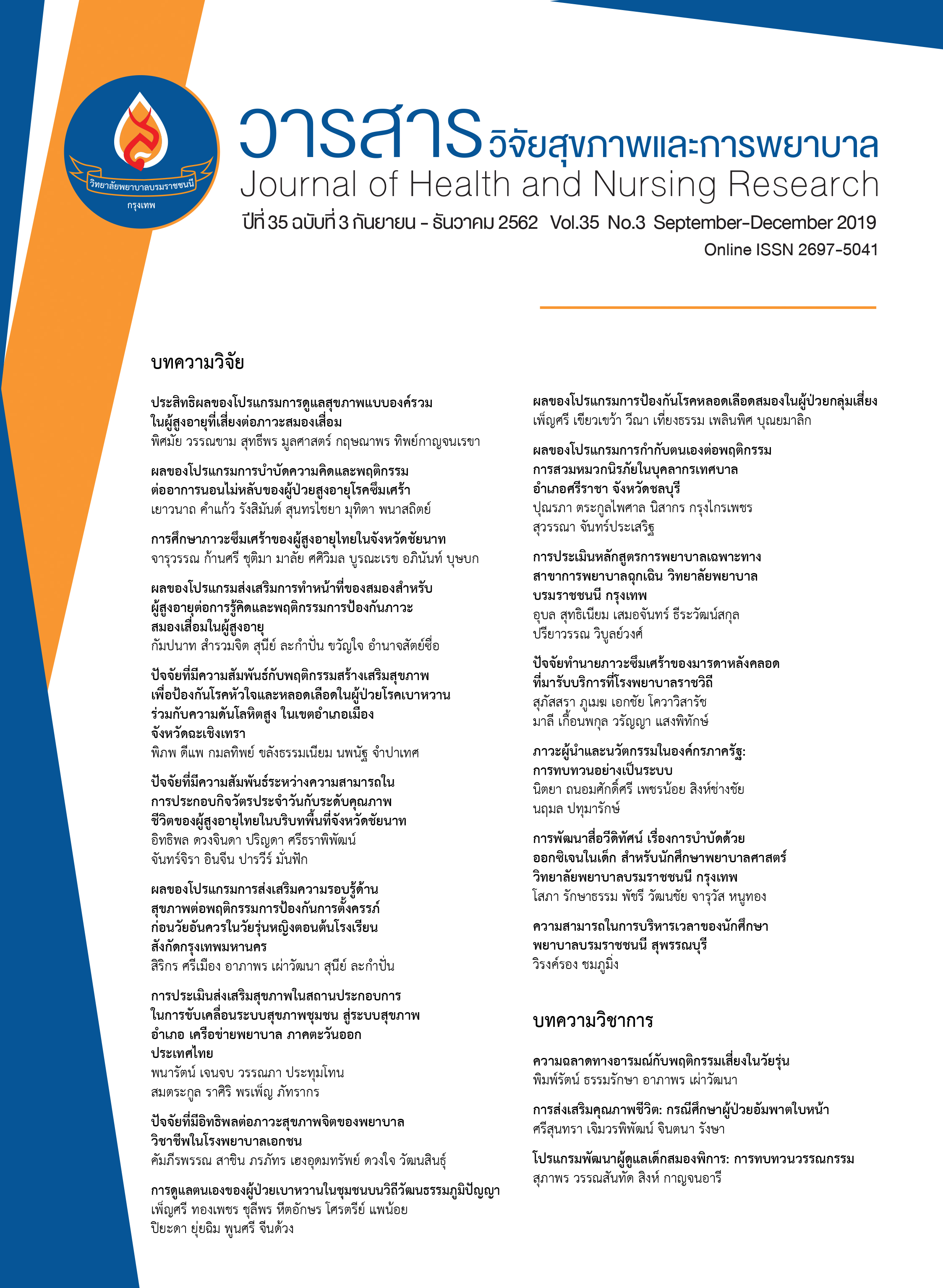ภาวะผู้นำและนวัตกรรมในองค์กรภาครัฐ: การทบทวนอย่างเป็นระบบ
คำสำคัญ:
ภาวะผู้นำ, นวัตกรรม, องค์กรภาครัฐ, การทบทวนอย่างเป็นระบบบทคัดย่อ
การทบทวนงานวิจัยอย่างเป็นระบบนี้ มีวัตถุประสงค์เพื่อศึกษาคุณลักษณะของรายงานการวิจัยที่เกี่ยวกับภาวะผู้นำสำหรับนวัตกรรมในองค์กรภาครัฐ และสังเคราะห์อิทธิพลของภาวะผู้นำต่อนวัตกรรมในองค์กรภาครัฐจากหลักฐานเชิงประจักษ์ โดยการสืบค้นรายงานวิจัยจากแหล่งข้อมูลต่าง ๆ คือ Medline, Pubmed, CINAHL, Google scholar, ThaiLIS ที่ตรงตามเกณฑ์การเลือก (inclusion criteria) คือ 1) เป็นรายงานวิจัยที่ศึกษาเกี่ยวกับภาวะผู้นำและนวัตกรรมในองค์กรภาครัฐ 2) รายงานการวิจัยต้องมาจากวารสารที่มีผู้เชี่ยวชาญ (peer reviews) ตรวจสอบและประเมินคุณภาพตามเกณฑ์ และ3) เป็นรายงานวิจัยเชิงปริมาณที่ตีพิมพ์ในช่วง พ. ศ. 2552-2561 ใช้แบบประเมินคุณภาพมาตรฐานงานวิจัย (Standard Quality Assessment Criteria for Research Papers) Kmet, Lee และ Cook ประเมินคุณภาพเครื่องมือด้วยทีมงานวิจัย ได้ค่าความน่าเชื่อถือ (Inter rater) ร้อยละ 83.53 และใช้สถิติแคปปา (Kappa statistic) ทดสอบความสอดคล้องกันระหว่างผู้ประเมินรายงานพบว่า การประเมินคุณภาพมีความสอดคล้องกันหรือไม่แตกต่างกันอย่างมีนัยสำคัญทางสถิติ (k =0.17, p = .13) และใช้สถิติเชิงพรรณนา
ผลการวิจัย พบว่า เป็นการวิจัยเชิงปริมาณทั้งหมด (n= 23) สถานที่ศึกษาพบในองค์กรภาครัฐจากหลายๆองค์กรมากที่สุด (n= 9) รองลงในบริบทด้านการศึกษา (n = 8) และบริบทด้านสุขภาพน้อยที่สุด (n= 6) ระยะเวลาการศึกษาพบในช่วง พ.ศ. 2557-2561 มากที่สุด (n= 19) ในช่วง พ.ศ. 2552-2556 (n= 4) เป็นงานวิจัยที่ศึกษาขนาดอิทธิพลการทำนายภาวะผู้นำกับนวัตกรรมในองค์กรมากที่สุด (n= 12) รองลงมาเป็นการศึกษาหาความสัมพันธ์ภาวะผู้นำกับนวัตกรรมในองค์กร (n=10) พบการศึกษาเชิงบรรยายน้อยที่สุด (n= 1) ส่วนใหญ่ใช้ขนาดกลุ่มตัวอย่างตั้งแต่ 200 – 300 ราย (n = 8) จำนวนกลุ่มตัวอย่างมากสุดคือ 8,640 ราย น้อยสุดคือ จำนวนตัวอย่าง 83 ราย เก็บข้อมูลโดยใช้แบบสอบถามทั้งหมด (n=23) แนวคิดภาวะผู้นำที่ใช้ในการศึกษาวิจัยมากที่สุด คือภาวะผู้นำการเปลี่ยนแปลง ของแบสและอโวลิโอ (n= 17) โดยใช้เป็นตัวแปรอิสระ(n = 22) และใช้เป็นตัวแปรส่งผ่าน (Mediator) (n =1 ) ส่วนตัวแปรนวัตกรรมในองค์กรใช้เป็นตัวแปรตามมากที่สุด (n = 21) เป็นตัวแปรส่งผ่าน (Mediator) (n =2) และนวัตกรรมในองค์กรภาครัฐที่พบมากที่สุดได้แก่ นวัตกรรมกระบวนการ (n= 10) นวัตกรรมผลิตภัณฑ์ (n= 7) นวัตกรรมการบริการ (n= 4) และนวัตกรรมการบริหาร (n= 4) ดังนั้นผลการสังเคราะห์งานวิจัยครั้งนี้จึงชี้ชัดว่าภาวะผู้นำการเปลี่ยนแปลงเป็นปัจจัยที่ความสัมพันธ์ต่อนวัตกรรมในองค์กรภาครัฐ
Downloads
เอกสารอ้างอิง
2. Denti L, Hemlin S. Leadership and innovation in organizations: A systematic review of factors that mediate or moderate the relationship. International Journal of Innovation Management 2012;16(3):1-20.
3. Dorsman SJ, Tummers LG, Thaen M. Understanding public sector innovations, The role of leadership activities for a climate for innovation. Public Administration 2015;1-21.
4. Cummings G, Lee H, Macgregor T, Wong C, Davey M, Paul L, et al. Factors contributing to nursing leadership: A systematic review. J Health Serv Res Policy 2008;13:240-8.
5. Beasu C, Benjinaru R. Leadership approaches regarding the organizational change. The USV Annals of Economics and Public Administration. 2013;13(18):146-52.
6. Moher M, Liberati A, Tetzlaff J, Altman DG, The PRISMA group preferred reporting items for systematic reviews and meta-analysis: The PRISMA statement. Journal of Clinical Epidemiology 2009;62:1006–12.
7. Kmet LM, Lee RC, Cook L S. Standard quality assessment criteria for evaluating primary research papers from a variety of fields. Canada: Interpret Design Inc; 2004.
8. Bass BM, Avolio BJ. Improving organizational effectiveness through transformational leadership. CA: SAGE. 1994.
9. Khan ZA, Nawazl A, Khan I. The impact of leadership style on innovation in health service, Gomal University Journal of Research 2015;31(1):143-54.
10. Tang H. Effects of leadership behavior on knowledge management and organization innovation in medicine and health sciences. EURASIA Journal of Mathematics Science and Technology Education 2917;13(8):5425-33.
11. Bagheri A, Akbari M. The impact of entrepreneurial leadership on nurses’ innovation behavior. Journal of Nursing Scholarship 2017;50(1):28–35.
12. Somech A. The effects of leadership style and team process on performance and innovation in functionally heterogeneous teams. Journal of Management 2009; 32(1):132-57.
13. Ricard MA. Innovation capacity in the public sector: What’s the link between leadership and innovation? research results from the LIPSE project on Innovation in the public sector funded by the 7th Framework Program of the European Union; 2014.
14. Ghanbari H, Eskandari A. Transformational leadership, job satisfaction, and organizational innovation. Journal of Management Perspective 2015;1(4):81-94.
15. Khan R, Rehman AU, Fatima A. Transformational leadership and organizational innovation: Moderated by organizational size. African Journal of Business Management 2009; 3(11):678-84.
16. Muchtar YC. The Influence of transformational leadership style on innovation mediated by organizational culture. Journal of Management Research 2014;6(4):176-86.
17. Tang H. Effects of leadership behavior on knowledge management and organization innovation in medicine and health sciences. EURASIA Journal of Mathematics Science and Technology Education 2017;13(8):5425-33.
18. Bagheri A. The impact of entrepreneurial leadership on nurses’ innovation behavior. Journal of Nursing Scholarship 2018;50(1):28–35.
19. Ali KAM, Buang M. Study on factors that influence innovation in Malaysian public sector. Journal of Advanced Research in Business and Management Studies 2016;4(1):60-73.
20. Dorsman SJ, Tummers LG,Thaens M. Understanding public sector innovations the role of leadership activities for a climate for innovation. Public Administration 2015;1-21.
21. Naguib HM, Naem AE. The impact of transformational leadership on the organization innovation. The International Journal of Social Sciences and Humanities Invention 2018; 5(1):4337-43.
22. Chen DX, Peng XB. Research on the relationship between transformational leadership and government service innovation. Open Journal of Leadership 2017;6:82-94.
23. Karimi F, Morshedi Z. The relationship between transformational leadership with organizational Innovation. Journal of Educational and Psychological Researches, 2015;1(3), 226-233.
24. Amri AY, Hassan R, Isaac O, Masoud Y. The effect of transformational leadership on organizational innovation in higher education: The case of developing countries. International Journal of Management and Human Science 2018;2(4):25-37.
25. Tang LL, Yeh YL. Effect of organizational culture, leadership style, and organizational learning on organizational innovation in the public sector. Journal of Quality 2015;22(5),461-480.
26. Zhang Dl. The effects of integrative leadership on the enterprise synergy innovation performance in a supply chain cooperative network. Sustainability 2017;10:1-20.
27. Zhang Y, Zheng J, Darko A. How does transformational leadership promote innovation in construction? the mediating role of innovation climate and the multilevel moderation role of project requirements. Sustainability, 2018; 10, 1-19.
28. Gomes C, Curral L, Caetano A. The mediating effect of work engagement on the relationship between self-leadership and individual innovation. International Journal of Innovation Management 2017;19(1):1-18.
29. Somech A. The effects of leadership style and team process on performance and innovation in functionally heterogeneous teams. Journal of Management 2009;32(1):132-57.
30. Aarons AG, Sommerfeld DH. Leadership, innovation climate, and attitudes toward evidence based practice during a statewide implementation. J Am Acad Child Adolesc Psychiatry 2012;51(4):1-15.
31. Mokekhaow K, Luangamornlert S, Chintanadilok N, Sritoomma N, The relationship model among transformational leadership, knowledge creation and innovation management performance in nursing units at community. Nursing Journal of the Ministry of Public Health 2017;27(3)163-75. (in Thai)
32. Abbasi B. Transformational leadership and change readiness and a moderating role of perceived bureaucratic structure: an empirical investigation. Problems and Perspectives in Management 2017;15(1):35-44.
ดาวน์โหลด
เผยแพร่แล้ว
รูปแบบการอ้างอิง
ฉบับ
ประเภทบทความ
สัญญาอนุญาต
บทความที่ได้รับการตีพิมพ์ เป็นลิขสิทธิ์ของวารสารวิจัยสุขภาพและการพยาบาล (วิทยาลัยพยาบาลบรมราชชนนี กรุงเทพ) ไม่สามารถนำไปตีพิมพ์ซ้ำในวารสารฉบับอื่น


















